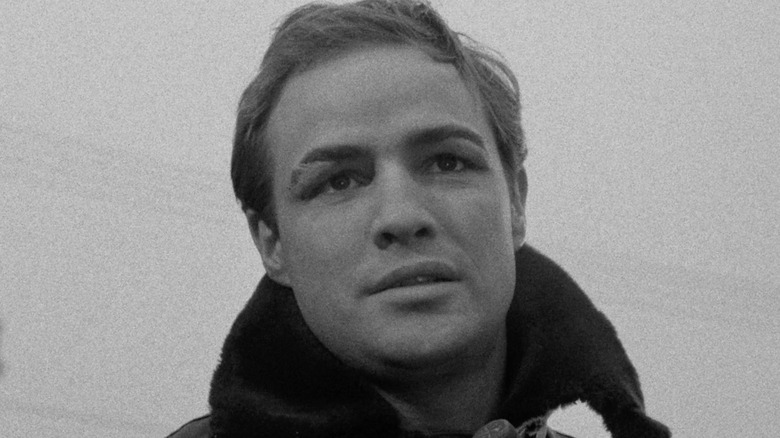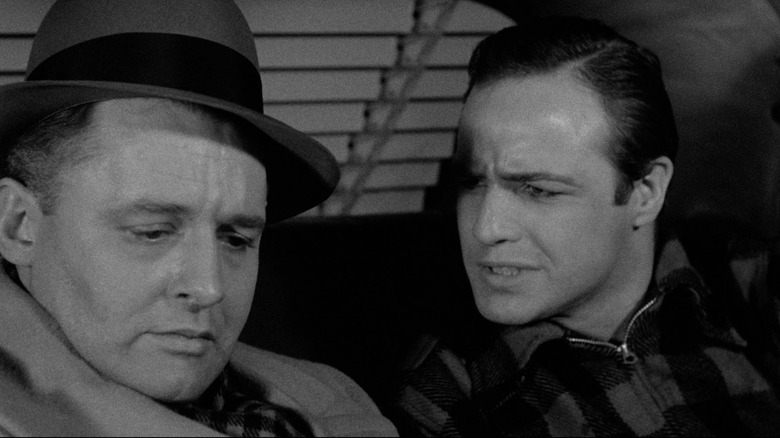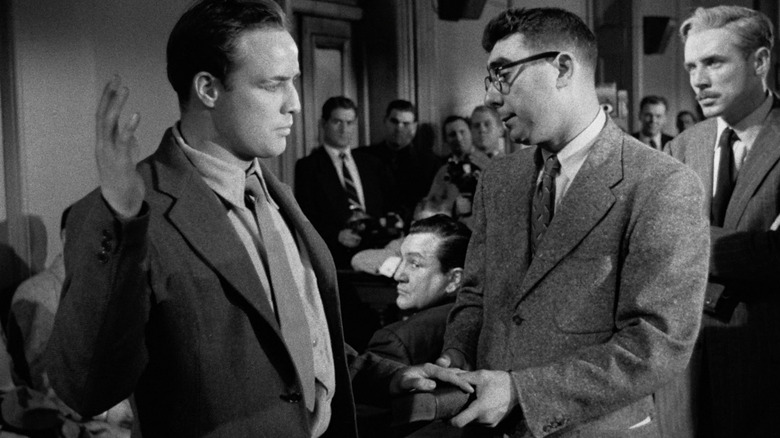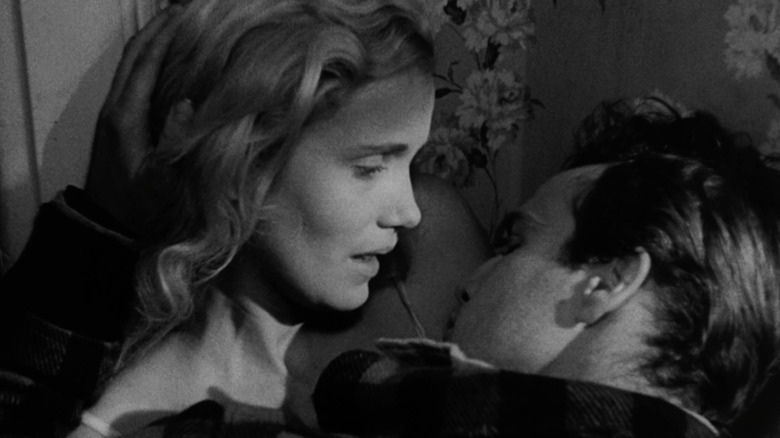On The Waterfront Ending Explained: A Canary In A Coal Mine
No actor in the history of cinema has had a greater impact on how to craft a performance than Marlon Brando. A student of legendary acting teacher Stella Adler, Brando broke open what a performer could do on screen in terms of spontaneity, speech, and internality. Initially criticized as a mumbler, he quickly became a lightning rod nobody could ignore, and now every actor who wants to go method fancies themself a new Marlon Brando, despite the fact that Brando was not a method actor (at least by the modern definition of the term). What helped rocket Brando to superstardom was he found a kindred spirit early in his career with director Elia Kazan.
The two first collaborated on the Broadway production of "Truckline Cafe," which ran a paltry 13 performances, but it was the next year when they would make a seismic impact with the original Broadway production of Tennessee Williams' Pulitzer Prize winning drama "A Streetcar Named Desire." When Kazan had the opportunity to direct the film adaptation of the play, he brought over almost everyone from that stage production, including Brando for only his second film role. It was a smash hit at the box office and earned Brando his first Oscar nomination for Best Actor, something he would receive every year for the next three years.
Three of those four nominations came from his films with Eliza Kazan, culminating in 1954 with Brando's first win with "On the Waterfront." Not only did Brando take home a trophy that year, but the film received 12 nominations total and took home eight of them, including Best Picture and Best Director. This was the industry finally passing the baton to these artists who eschewed traditional Hollywood filmmaking for New York-developed social realism. Nearly 70 years later, "On the Waterfront" remains a seminal piece of American drama that still speaks to the harsh realities of the working class.
However, its conception, as well as its ending, have a much more complicated history than the story of an underdog trying to persevere in life would maybe have you believe.
Could have been a contender
Brando takes on the role of Terry Malloy, a former boxer and now dockworker and low-level thug for the corrupt longshoreman union leader Johnny Friendly (Lee J. Cobb). After duping a fellow worker into a situation that leads to his murder, the pressure is being put on Terry by the cops and a local priest (Karl Malden) to testify against Friendly and his gang in court, even though the punishment by the gang for being a "canary" will be heavy if he does so. Meanwhile, he begins a complicated courtship with Edie (an Oscar winning Eva Marie Saint), the sister of the dead worker.
What makes the legacy of "On the Waterfront" a little sticky comes from its third act. Ultimately, Terry does decide to testify against the Friendly gang. On its face, this seems like a the right thing to do. These corrupt officials are endangering the livelihoods of the union members, sometimes even murdering them. They exploit them for wages to make heavy profits for themselves. Providing evidence to put these guys away seems like the natural, right thing to do. It would show the value of a union with a strong membership, willing to fight for their rights as workers and human beings.
Reading the film in this way makes "On the Waterfront" a paragon of working class filmmaking. For the film to be as effective as it can be, you have to read it that way. What muddles things greatly comes from the real life history of director Elia Kazan.
Kazan named names
One of the most embarrassing chapters in the history of Hollywood was the era of the blacklist. The United States was very keen on exposing and destroying the lives of communists, or even supposed communists, in America in the late 1940s and 1950s, setting up the House Un-American Activities Committee to find these so-called subversive actors. Hollywood was seen as a maker of communist propaganda (wow, has nothing changed?), and HUAC set their sights on stopping any notion of that, with Hollywood cooperating. Filmmakers, writers, and actors were routinely brought before HUAC to identify these people, and if they were named, they were put on a blacklist, with most never working again. It was a much more serious thing than terrible biopics like "Being the Ricardos" and "Trumbo" would have you believe.
If you stood in solidarity with your fellow human beings, you would not have named anyone. Eliza Kazan did not do this. In 1952, Kazan testified before HUAC and named eight people, most notably the great playwright Clifford Odets. For many in the industry, this was a complete betrayal, which it was. He sold out people who had done absolutely nothing wrong, committed no crimes, and were just living their lives with their own beliefs. People in Hollywood never forgot it either. Arthur Miller, who wrote the original draft of "On the Waterfront," refused to continue collaborating with Kazan after his hearing. In 1982, Orson Welles still called Kazan, "a traitor," for what he did, as recounted in the book "What Ever Happened to Orson Welles?: A Portrait of an Independent Career" by Joseph McBride. When Kazan received the Lifetime Achievement Oscar in 1999, many of the attendees refused to applaud or stand for his award. Nearly 50 years after he had named names, people could not erase that sting.
"On the Waterfront" could very easily be seen as Kazan trying to justify why he did what he did, and in that light, that third act is a little hard to take. Welles referred to the film as "a celebration of the informer." Framing "On the Waterfront" as a portrait of the common man and the need for good unions and workers rights feels completely incongruous to what Kazan's actual testimony accomplished, considering that the communists he named would believe in those ideals more than anyone.
The death of the author
A struggle so many people who enjoy film have to contend with is how much we tie up the people who make it with the actual artistic object itself, particularly in the era of #MeToo. Can one still enjoy the art made by someone who did horrible things in life? Does a piece of art no longer belong to the person who made it once it is in the world? How do I celebrate the work of the good people involved when one bad person in the mix challenges that? These are the questions people have to ask themselves when it comes to watching "On the Waterfront." Even beyond Elia Kazan, can you still even enjoy a Marlon Brando film after what he did during the making of "Last Tango in Paris"? These are not easy questions to answer.
Elia Kazan and Marlon Brando have both been dead almost 20 years now. They can no longer profit off "On the Waterfront" or say anything else about his intentions behind why they made it. They also can't receive any more adulations and awards for their work. People have the ability to come to the movie at any point in their life for the first time and imprint anything they want to on it, and with the people behind "On the Waterfront" gone, with the notable exception of Eva Marie Saint still kicking at age 97, the opportunity to see this film through your own fresh lens is entirely possible. "On the Waterfront" can no longer belong to them, so it now belongs to us. We can enjoy and be moved by the movie however we want. If you want to be contextually blind, you can do that. If you do know all of this true history, it actually has the potential to enrich how you see the film.
Regardless, "On the Waterfront" remains a remarkably made film that raises important questions about society and class that sadly seem evergreen. Orson Welles even had to admit about Kazan, "In other respects, he's one of our great directors," and if you want to see why, go watch "On the Waterfront."



